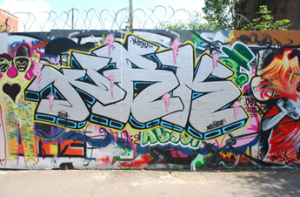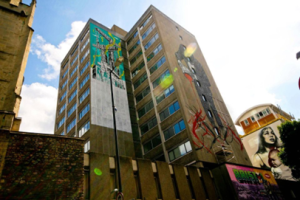The History of Graffiti and Rebellion in Bristol
In 19th century Bristol, chalk was used to write on walls to portray messages and ideas; this practice, called ‘chalking’ was not always a political act. Chalking was rejected by the upper class who would cover these chalked walls with paper advertisements for their businesses. The use of chalk to write on walls could arguably be one of the origins of graffiti in Bristol. Chalking had similar repercussions as graffiti does today, with the rejection of temporary messages through the grey washing of street art and tags under Marvin Rees political campaign as Bristol Mayor, with reportedly around four thousand graffiti tags so far repainted with grey paint.


The grey washing of painted walls has received backlash from the Peoples Republic of Stoke Croft and other community organisations around Bristol, who regularly combat the council to provide legal space for artists to paint and practice their work. They argue that by allowing artists to use practice walls, where tags and messages can be painted over regularly by others to practice their art, this will reduce the amount of graffiti tags on illegal walls. This is due to the creation of legal space for artists to express themselves and share messages meaning there is less desire to do it on illegal walls. The practice wall on Ashley Road has seen reports from locals stating that random graffiti and tagging has declined hugely in the local area, suggesting that the creation of space for art is a better solution than grey washing it completely as this creates more conflict.

The culture of Graffiti in Bristol is arguably a part of it’s identity, with Banksy being a big influence, as a Bristol born artist. The exhibition of his work in mainstream galleries, such as the ‘Crimes of Passion’ display at the RWA, has helped to add to the acceptance of street art in Bristol through the display of graffiti alongside classic art. Another breakthrough was the ‘See No Evil’ project in 2011, which saw the sides of tall concrete buildings in the city centre painted with huge murals. This project has become a huge tourist attraction and combined with Banksy’s work, completes many of the street art tours bringing people to all parts of the city. Bristol is also home to Europe’s largest Graffiti festival, Upfest, bringing in tourists from all over world. Upfest celebrated its 15th anniversary last year with around 50,000 people attending to watch over 400 artists paint live. Upfest shows how Bristol has become a global hub for street art with artists from over 50 countries coming to the city to paint.

Undoubtedly, graffiti and street art are a huge part of Bristol’s culture. Graffiti will continue to be tangled with anarchy and social change in Bristol, through political murals and links to protest. It is unlikely grey washing will put a stop to Bristol’s rebellious identity and expression via graffiti. Graffiti comes hand in hand with rejection, whether it started with chalking being covered with advertisement or spray paints being grey washed. The messages shared and the council walls used all add to rebellion that graffiti is used to express. Banky’s ‘Well-Hung Lover’ on Park Street was painted on a council owned wall and came under fire by the council to get rid of it but due to immense public backing it is now one of the most famous spots in Bristol. Graffiti is a powerful visual tool to see social change and anarchy as it happens and the rejection it faces just adds more meaning to its message.

Author: Nell Beckett, 2nd Year Anthropology BA Student, University of Bristol

